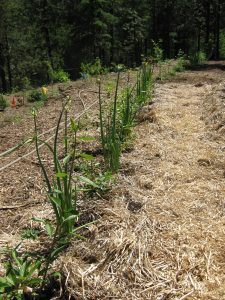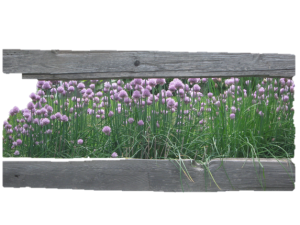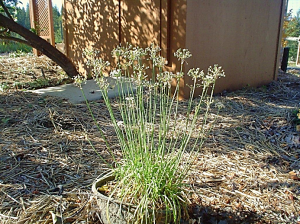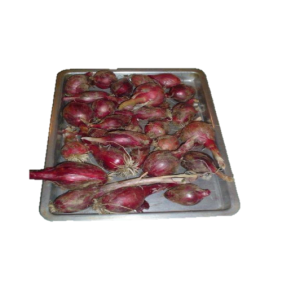Originally I thought this would be a piece of cake. Good for allergies. What could be simpler? Write a little article on onions. Wrong. Couldn’t believe it took me several days to gather and consolidate all the information. Here it is:
Table of Contents
The Onion Family
(Allium cepa) Family: Liliaceae, Alliaceae
Alias names for Onions: Rahona (meaning “lacking one taste—sourness” Cong bai, Cong xu, Jiu zi

Egyptian Walking Onions in our permaculture orchard.
Common Varieties of Onions:
- Allium ampeloprasum –elephant garlic, round-headed garlic (not discussed in this article)
- Allium ascalonicum (clusters of small bulbs) the variety kurrat (from the Middle East) is used like chives. Pearl onions (from Europe and Italy) are produced for pickling.
- Allium cepa (onion) contains many varieties including: A. aggregatum (shallots), A. bulbiferum (bulb onions), A. cepa (the common onion), A. multiplicans (Egyptian walking or multiplier onions), A. proliferum (tree or Catawissa), A. solaninum and A. viviparum.
- Allium chinense (rakkyo) A type of bent-looking scallion sold as an entire head–not so commonly grown in the United States. Read more here: https://up-your-toot.blogspot.com/2011/11/overlooked-herb-kiangsi-scallion-allium.html
- Allium fistulosum (used in Chinese cuisine) Welsh onion, scallion, spring onion
- Allium sativum or controversum—garlic. We won’t discuss garlic here because there is so much information on it that it needs its own page.
- Allium schoenoprasum var. sibericum –The common chive. Leaves, bulbs and flowers are all used.

- Did you know you can eat the chive flowers?
- Allium tricoccum—commonly known as ramp, ramps, spring onion, ramson, wild leek, wood leek, and wild garlic (Read more: https://en.wikipedia.org/wiki/Allium_tricoccum)
- Allium ursinum—Also known as buckrams, wild garlic, broad-leaved garlic, wood garlic, bear leek or bear’s garlic (Ref: https://en.wikipedia.org/wiki/Allium_ursinum
- Allium tuberosum Chinese chives, garlic chives, cuchay –used for vomiting (use seeds) and as a worming agent. Chinese chives also improve kidney function. Added to salads, soft cheeses and stir-fries. Don’t cook too long for best effects.

Garlic Chives and white flowering edible heads.
About Onions: A perennial herb originating in Central Asia include some species growing up to four feet tall with hollow leaves (usually—except for Chinese chives) with greenish white flowers. Onions are one of the leading vegetable crops in the world. Onions have been used in Greek and Roman times for over 5000 years and have been seen on ancient monuments in Egypt. Columbus first brought the onion to the Americas.
The onion vapor containing sulfur that escapes when the onion is cut is hydrolyzed and turns to sulfuric acid causing the familiar eye irritation and tearing. Corneal swelling has been reported from people handling and cutting onions. It is advised to always cool the onion to less than 50 degrees F, use a sharp knife (or food processor) when chopping onions to prevent crushing and/or to hold the onion under water as it is cut into. Leaving the root end on the onion to cut off last also helps with limiting the release of the volatile oils as this is where most of the oils are.
Muslim legend teaches that when satan left the Garden of Eden after the Fall that garlic sprang up from his left footstep and onion from his right.
There are many superstitions surrounding garlic (in the onion family)
-
- Wards off vampires
- Causes moles to leap out of the ground (ah if it were that easy)
- If chewed it prevents competitors from getting ahead in races
In Ayurvedic medicine onions (among other foods) have been documented in the Vedic spiritual texts of India for thousands of years. In this area of medicine people are trained to listen to their bodies and note how foods affect them. For example, garlic may drop the vibrational level or cause an ‘energetic fog’ or depression when overused and should only be used as a medicine—not as a commonly eaten food. Onions cause emotional irritability in some people within an hour of eating them. To read more on this topic, two links supplied by one of my clients are:
Foods to Avoid and Eat for a Yogic Diet: https://www.mindbodygreen.com/0-5870/The-Yogic-Diet-10-Foods-to-Enjoy-Avoid.html and the emotional effects of food: https://ayurvedaplace.com/2011/09/05/food-affects-mind-sattvic-rajasic-tamasic-food/
(Note: Thanks to Christina James for this information.)

Allium cepa, the yellow storage onion.
How to chop an onion like a pro (2 min. video): https://www.onions-usa.org/faqs/why-do-your-eyes-water-when-you-cut-onions One medium onion produces about a cup of chopped onion. Tip: To get the odor off your hands or off wood or plastic cutting boards, use lemon juice. To get the odor off of metal, rub the surface with salt.
Historical Uses of the Allium Family:
- Acne
- Allergies
- Anticancer agent especially for colon, renal, stomach and breast cancers
- Antifungal
- Antimicrobial—Eating onions on your hamburger decreases the Salmonella typhimurium (when present). Onions also work to heal Streptococcus mutans, Strep subrinus, Porphyromonas gingivalis and Prevotella intermedia (the main causes of dental caries and periodontitis)
- Antioxidant
- Anti-parasitic
- Appetite loss
- Asthma—Inhibits bronchoconstriction
- Boils
- Bronchitis
- Cardiovascular support—hypolipidemic effects (it decreases plaque formation inside the arteries)
- Combined with garlic and milk to break up chest congestion
- Decreases cholesterol and triglyceride production
- Decreases platelet aggregation (maybe not if the onion is cooked)
- Diuretic
- Dysentery (garlic)
- Ear aches (wild leeks applied topically)
- Frostbite (and other like cases of extreme cold)
- Hay Fever
- Helps prevent harm from nicotine exposure
- Improves glucose levels—hypoglycemic action
- Indigestion
- Interstitial cystitis
- Low yang energy
- Lowers the blood pressure
- Prevention of infection
- Prevents blood clots from forming
- Relaxes spasm
- Spring tonic (wild leeks)
- Stingray wounds
- Urinary incontinence (Chinese chives)
- Urinary Tract Disorders
- Warts
- Whooping cough
Parts of Onions Plant Used: The bulb which is made up of many leaf sheaths forming a thin-skinned capsule are eaten fresh, dried (chopped or powdered) or cooked. Onions have been used as plasters, poultices and syrups over the years being applied topically or ingested. Onions also contain essential oils.
Raw onion makes many people nauseous but cooking it does not have the same effect. High heat makes an onion taste bitter so always cook on low to medium heat. An onion cooked to “sweat” stage should be limp and clearish on the edges. If there is any browning of the onion the sugars have caramelized. Different onion dishes will call for varying degrees of this cooking process.
Many people don’t like the texture of the onion. Others are sensitive to “onion breath”. Tastes change over the years. It seems young children don’t care much for onion. To relieve onion breath eat a few sprigs of parsley or chomp on a little bit of a citrus peeling or rinse your mouth out with a sip or two of lemon water. Some cooks will intentionally reduce the pungency of an onion by soaking the chopped vegetable in ice water for 90 minutes then rinsing under cold water for a minute.
Onion skin is used to dye eggs (yellow) and also used for dying clothing and wool.
Onions can be made into a tincture or used as a homeopathic remedy (Allium cepa). Chive flowers are used in cooking and in salads.
The onion family is used in egg dishes, with potatoes, in soups, soft cheeses, to flavor meats and vegetable dishes, in sandwiches, sauces and with fish.

Bermuda Onions
How to Store Onions: Keep dry bulbs uncovered in a dark, well ventilated place and never in plastic bags. Sweet onions have a higher water content than yellow storage onions so are more susceptible to bruising and a decreased shelf life (you may wrap each sweet onion in a paper towel or in some newspaper then refrigerate to help extend its storage time).To store whole, peeled onions refrigerate them at or below 40 degrees F. Chopped or sliced onion will keep in a sealed container in the refrigerator for 7-10 days. Onions can also be frozen or dried.
Properties and chemical constituents of Onions: Onions contain 89% water, 1.5% protein, are high in potassium, vitamins B1, B2 and in Vitamin C (yellow onions are the highest in vitamin C). They contain polysaccharides (fructosans and saccharose), peptides, flavonoids and essential oil. Alliin and other sulfur compounds including allylalliin, methy and propyl compounds of cysteine sulfoxide give the onion family its strong flavor. Prostaglandins (anti-inflammatories) are also found in onions. Onions contain Quercetin (an antihistamine) and are used for all kinds of allergies.
Contraindications, safety issues, concerns, harmful drug interactions and allergy precautions for Onions:
Cats are very negatively affected by any onion in their diets. The sulfur compounds destroy the red cells within the body causing anemia and death. A couple of decades ago we used to feed critical care cases meat and vegetable baby foods in the tiny little jars until someone noted that there was actually onion in the meat foods! It’s not so good to feed onion to dogs either (especially ones with sensitive stomachs). And forcing livestock to eat tons of them is not safe for them either. You wouldn’t eat an entire diet of onions, why should the animals that supply us with meat be subjected to that?
There are no side effects, contraindications or interactions for humans ingesting onions.
Choosing the Best Onions: In general, when you’re choosing onions in the store, the best ones will be firm, have a crackly outer skin, and have no scent or just a mild scent. Stronger scented onions are an indication that the onion is starting to spoil. Avoid onions with dark spots or mold.
Cultivation of Onions: The onion family contains many, many species and it seems there is an onion variety for every type of soil and light condition. Mostly though this family likes rich, well-drained soil and full sun (except for ramps—they like growing under some types of deciduous trees). Onions are the perfect companion plants for beets, tomatoes and other nightshades, brassicas (like broccoli, cauliflower, collards), lettuce, summer savory, chamomile, peaches/apricots/almonds and any of the rose family (which includes apple trees). The onion family deters rabbits, slugs, aphids, cabbage loopers/maggots/worms and Japanese beetles. Don’t plant onions next to your beans, peas and parsley though as they don’t like each other.
Helpful Links and References for Onions:
-
- Book: The Review of Natural Products: The most complete source of natural product information edited by Facts and Comparisons © 2001 ISBN 1-57439-100-3.
- Choosing Onions: https://thecookingdish.com/0330/the-difference-between-yellow-onions-white-onions-and-red-onions/
- Read more on Chives here: https://www.missouribotanicalgarden.org/PlantFinder/PlantFinderDetails.aspx?kempercode=j270
- National Onion Association: https://www.onions-usa.org/faqs.